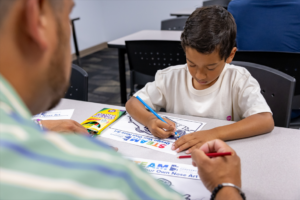Museums are known for their preservation and exhibition of important cultural, artistic, historical and scientific artifacts. However, many museums offer more than just displayed artifacts. Educational programs and offerings are an important element of museums, especially here at the Hill Aerospace Museum, as we look to integrate different opportunities for formal and informal education. These educational experiences can teach, inspire and connect with visitors and the community.
TEACH
Interacting with museum displays and information allows kids and adults alike to engage and enjoy an informal educational experience, while learning more about objects, culture, tradition and history. Museums often teach through informal learning—an unstructured and spontaneous educational experience. This type of learning occurs naturally and every day. In fact, studies show that preschool children spend about 80% of their waking hours engaged in informal learning outside of school settings.[1] Research shows that adults similarly participate in informal learning with about 60% of adults aged 25–64 participating in an informal learning experience including visiting a museum or historical site.[2]
Many museums elevate their educational missions by providing more formal learning experiences such as structured classes or learning sessions. For example, Hill Aerospace Museum offers Steam Summer Passport Program, field trips and guided tours as structured learning offerings. Unstructured learning happens while exploring the galleries or doing one of our Scavenger Hunt activities.

Our education classes provide students with STEAM (Science, Technology, Engineering, Art and Mathematics) education concepts and principles. While the acronym adds just one more category to STEM education (Art), it connects the sciences to real-life scenarios and allows children to take what they learn and practice it creatively. For us, this means an additional emphasis in two areas: history and culture. By incorporating history with art, Hill Aerospace Museum’s Education Center helps children to connect distinctive science topics to the significance of a more comprehensive perspective.
While many education programs have begun to explain the sciences in more practical, art-driven ways, our use of historical examples of art and aerospace mechanics differentiates us from other educational programs and helps us create thorough, entertaining lessons that captivate a student’s attention. STEAM allows us to move from singular explanations of science topics to an experience that involves more of the human story, art and curiosity.
INSPIRE
From the awe-inspiring to the surprising, museums create reactions only available through witnessing something remarkable. Visitors of the Smithsonian National Air and Space Museum can touch a moon rock. Walking around Frank Lloyd Wright’s famous Guggenheim Museum elicits architectural wonder. Many other museums also have artistic and cultural exhibitions that evoke an unrivaled fascination.
Perhaps little in this world is more inspiring than manned flight. From its humble and unrestrained beginnings in 1909 with Wilbur and Orville Wright’s Model A to the earth-shaking power of modern aircraft, human flight has inspired imaginations for more than 100 years. And Hill Aerospace Museum has an impressive collection of both modern and antiquated aircraft that beg wonder and rumination.
Museums can provide a memorable, immersive learning experience; visiting one can provoke imagination, introduce new subjects and offer unique learning experiences.[3] Providing an opportunity for hands-on learning about chemistry, forces of flight, weather and more can inspire added scientific exploration and further curiosity of these topics and more.
CONNECT
 Museums offer visitors the opportunity to not only connect with artifacts, inventions and cultures across the spectrum of time and space, but as a community meeting place, fostering new relationships. Local museums can provide a sense of community by celebrating a collective heritage or history.[4]
Museums offer visitors the opportunity to not only connect with artifacts, inventions and cultures across the spectrum of time and space, but as a community meeting place, fostering new relationships. Local museums can provide a sense of community by celebrating a collective heritage or history.[4]
The Hill Aerospace Museum hosts several free events throughout the year to provide an opportunity to gather and learn as a community. Our quarterly Plane Talk series, Open Aircraft Day, the annual Easter Egg Hunt and recently added, Back to School Night, offer a unique experience for community members to engage with our collections in a different way, and still provide an educational experience.
While sitting and listening to a speaker talk about piloting the F-117 Nighthawk or about serving in World War II are considered more formal learning experiences, attending an event like Open Aircraft Day can be an engaging, informal experience. Peeking into the cockpit of the A-10 Warthog and listening to volunteers tell stories of their maintenance or piloting days are just as important learning experiences.
CONCLUSION
Museums are great places for informal learning experiences for kids and adults alike! Exploration led by wonder and curiosity can unlock new interests into new topics. Downloading one of our scavenger hunts and searching the galleries for each item is a great example of informal learning.
In 2023, the education team at Hill Aerospace Museum provided over 200 formal learning opportunities for K–12 students between outreach, field trips and our Summer Steam program. These structured learning offerings, paired with self-guided exploration of over 70 aircraft, created a memorable experience for our visitors. We hope that our efforts provide opportunities to teach, inspire and connect with visitors and the community in a fun and memorable way.
With free admission to Hill Aerospace Museum, it can be hard to find a reason not to visit.
Visit Hill Aerospace Museum from 9 a.m. till 4:30 p.m. Monday through Saturday. It’s easy to find—just take exit 338 off I-15. With a C-124C Globemaster II at the front of the building, you can’t miss it!
[1] https://www.ncbi.nlm.nih.gov/pmc/articles/PMC9320717/
[3] https://www.arts.gov/stories/blog/2014/importance-taking-children-museums
[4] https://www.museumnext.com/article/why-we-need-museums-now-more-than-ever/
